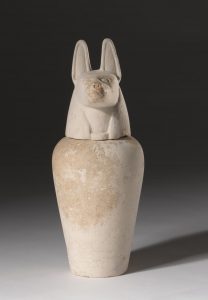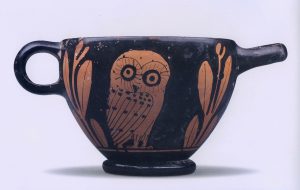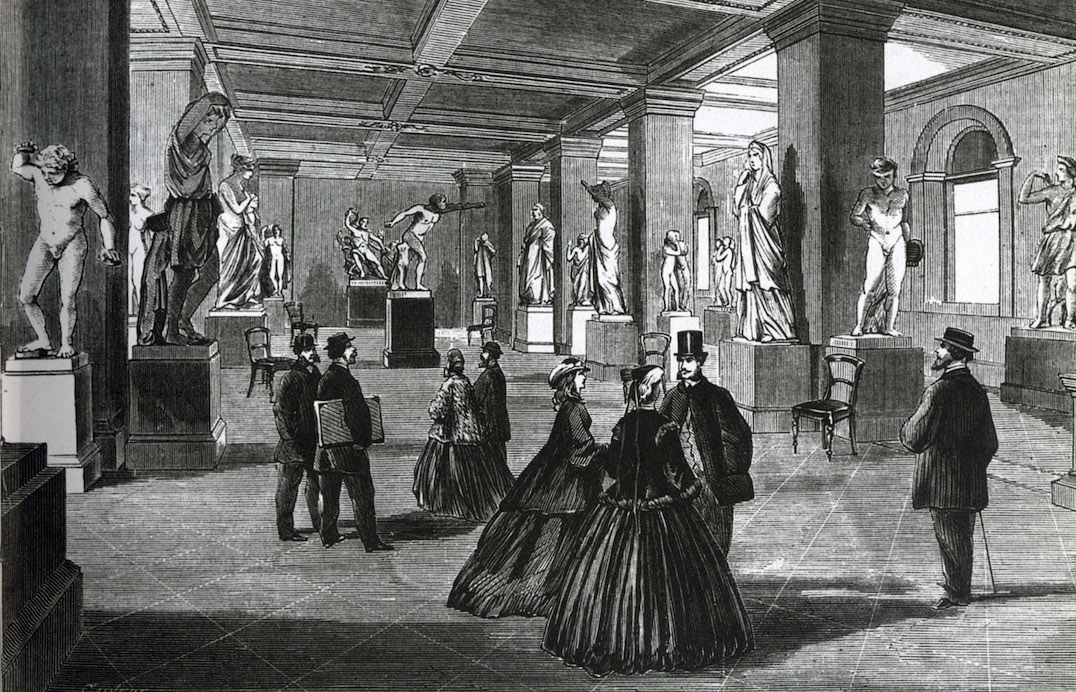Samuel Calvert: Sculpture Gallery, Melbourne Public Library: wood engraving, published in The Illustrated Melbourne Post, 27 July 1866 (SLV)
Introduction
The hyperbole with which prominent local critic James Smith described the Melbourne Public Library’s new Sculpture Gallery when it opened in 1865 reveals both the classicizing aspirations underlying the new collection, and their obvious limitations:
“Enough that we can contemplate the creation of Phideas as fresh and as real as if actually chiselled in the marble by his own hand. We may indeed be well satisfied with the beginning we have made of such excellent and beautiful casts… these including the Parthenon slabs from the Elgin collection in the British Museum amount to close on 100 works.”
The acquisition of plaster casts of Greco-Roman statuary (which continued throughout the pre-Felton period, along with casts of busts of famous men, and various Renaissance and other statues) obviously provides important evidence of the taste and ideas underpinning the early development of the Melbourne Public Library and its art collections (see now Plaster Casts). Redmond Barry’s detailed notes on the statues and their subjects were incorporated in various NGV catalogues through to 1894, revealing the continuing fascination of many in the period with the history and culture of antiquity.
There was also abundant evidence elsewhere in the early collection of the high value placed on antique sculpture, through reduced-scale marble and bronze replicas (see e.g. * Unknown (Italian 19C?) Venus de’Medici {1878} Loc? [SC]), photographs and prints (see e.g. Girard after Reverdin Laocoon {by 1868} NGV [PR]), and classicizing statues from the period itself by Benzoni, Canova (or an imitator), Marshall Wood and others.
For all this enterprise, however, no original antique statues, and few significant ancient works in other media, entered the collection during the pre-Felton era. Wise after the event, one might even go so far as to opine that all the money and energy expended on plaster casts and other classical copies for Melbourne prior to 1905 would have been spent much more wisely on a handful of significant original antique sculptures.
Admittedly, a substantial group of characteristic albeit small-scale Egyptian objects was assembled by 1904/5 (many of them donated in 1899: see detailed comments below). And some significant acquisitions of Etruscan and Greek pottery also occurred in the 1890s, providing a foundation for judicious subsequent purchases during the Felton era (especially of South Italian pottery, recommended by Professor Dale Trendall in the 1950s-60s).
[NB It should be emphasised that this summary of ancient material in the pre-Felton collection is preliminary and incomplete, pending more detailed examination of the records. Works marked # are reproduced in the NGV’s online catalogue.]
Egyptian

Ancient Egyptian art was represented in Melbourne’s pre-Felton collection by an extensive group of small-scale works: scarabs, fragments and components of tomb decoration, including several small “Ushabti” figures (statuettes of helpers), pottery and other domestic items. Many remain in the NGV, although some (including several mummies) no longer appear to be extant.
Most of the material was acquired by donation, notably a collection of over 300 objects donated in 1899 by the Egypt Exploration Fund (EEF), headed by English archaeologist Sir William Matthew Flinders Petrie (1853-1942), the grandson of the explorer Matthew Flinders. These comprised finds from his excavations at Diospolis Parva (on the Upper Nile, now called Hu or Huw; Diospolis Parva is the Ptolemaic name): see references below.
Select list:
- Scarab in green stone, donated by Mrs Airey 1862. NGV D231-1994
- A group of works donated by A.Schwalky 1868, including a late/Ptolemaic Head of a King (NGV 24B-D1A), and three fragmentary Ushabti figures, all dating from the XIXth to XXIInd Dynasties, c.1295-715 BCE (NGV 24C-D1A to 24D-D1A)
- Egyptian examples in a group of small ancient artefacts listed in AR 1871 as purchased from a Mrs Foote: two Ushabti figures (?), and a small oven for burning incense (none extant?)
- Four Ushabti figures donated by Signor Spiro Magnarisi (listed in AR 1874 as “idols”), two apparently extant (NGV 7-D1A # and 8-D1A) [listed in NGV catalogue as acq.1881].
- A donation by James Sherrard in 1881 comprised three mummies (no longer in the collection?), and various tomb items, including a canopic jar with lid showing the jackal-headed deity Duamutet (guarding the stomach), c.1069-664 BCE (NGV 2.a-b-D1A #): see photo
- Another group of Egyptian objects was purchased in 1888, including further Ushabti figures, notably a fine example identified by its inscription as made for the Overseer of Royal Barges in the reign of Amasis, 570-526 BCE (Dynasty XXVI) (NGV 49-D1A #)
- The large group of objects presented by the Committee of the Egypt Exploration Fund (EEF) in 1899: see general remarks above. These include Predynastic pottery from the period around 3500 BCE (e.g. a clay jar decorated with stylised birds: NGV 740-D2 #); and various limestone fragments of tomb relief sculpture from Dendara, c.2345-2160 BCE (e.g. NGV 798-D2 #); and various scarabs, mortuary stelae etc. from later periods (e.g.mortuary stela, 200-30 BCE: NGV 793-D2 #)
- Several fragmentary objects presented by Mrs H.Darlot in 1901, including a piece of papyrus containing script and images (NGV 717-D2 #)
- Finally, in 1904, several objects were presented by the Committee of Patrons of Mr John Gastang’s excavation at Beni Hasan, mostly Old/Middle Kingdom jars and vessels (e.g. jar, 2181-2020 BCE: NGV 478-D2 #), and some coffin fragments
Greek, Etruscan and Roman

Besides the plaster casts of Greco-Roman statues, reproductions of other ancient objects were also purchased occasionally (e.g. copies of Roman glass: see e.g. AR 1889, p.41, listing examples “reproduced from forms in the British Museum”).
Nevertheless, various original objects, mostly pottery,
were donated and acquired during the period, as witnessed by the following selection:
- 2 Roman earthenware lamps (1st/2nd century), acquired with funds donated by F.Dalgety 1862 (NGV 155/156-D1A)
- A miscellaneous collection of Roman lamps, tiles from ancient Seville, fragments of wall-paintings etc., donated by Sir Redmond Barry; mostly extant in the NGV (e.g. Tile from the Palace of Tiberius at Capri: NGV 1025F-D1A)
- Etruscan vase, listed in AR 1889, p.44, as donated by Professor Giglioli, Florence. Location unknown
- Roman brick from excavations at Roman Bath, England (era of Vespasian), donated by Rev.Joseph King, 1890: NGV 1925R-D1A
- “Collection of 118 objects illustrating Prehistoric Archaeology, obtained from the British Museum, by Sir John Lubbock, in exchange for a collection of ethnological specimens” (AR 1892, p.25). Included in this collection may be several Iron Age Cypriot jugs and vases extant in the NGV (e.g.72C-D1A: described as “white painted I ware,” and dated to 1050-750 BCE) (for similar works, acquired later, see Dunsmore 2004, p.43). Some of the examples listed below may also belong to this group.
- Stirrup Vase from Mycenae (late Bronze Age, 1400-1300 BCE), acquired 1892 (NGV 72E-D1A)
- A large group of ancient Greek and Italian (Etruscan, Apulian etc.) vases and jugs was acquired in 1893-4; many of these are still extant. Notable examples include a Red-figure Attic Syphos (450-425 BCE), decorated with an owl, the symbol of Athena, acquired 1893 (NGV 80R-D1A): see photo above. For other examples acquired in 1893-94, refer NGV catalogue (acc.no.80B-D1A etc. and 159-D1A etc.)
oOo
Refs.
For a good overview of Melbourne’s antique collections, see Dunsmore & others, Ancient Civilizations (2004)
James Smith’s review of the new Melbourne Museum of Art (Argus 7 June 1865) is quoted in Galbally First Collections (1992), p.80. For details of the cast collections, see NGV catalogues for 1865, 1880 and 1894 (refer Bibliography); and for further comments on the plaster casts, see Ann Galbally, “The Lost Museum: Redmond Barry and Melbourne’s ‘Musée des Copies’,” Australian Journal of Art vol.VII (1988), pp.29-50
For the Egypt Exploration Fund donation, see e.g. Flinders Petrie, Diospolis Parva: The Cemeteries of Abadiyeh and Hu 1878-9, London: Egypt Exploration Fund, 1901 (available via Google Books)


